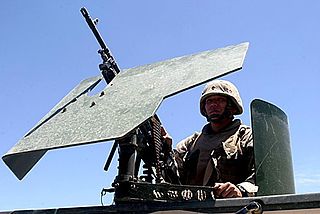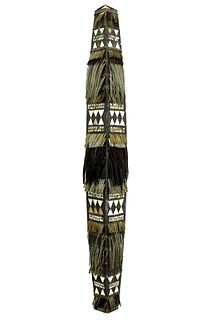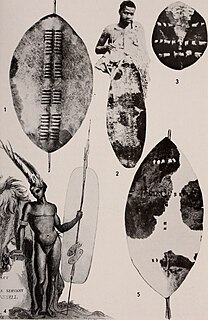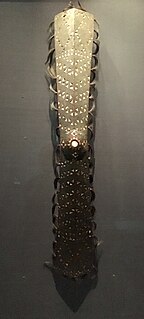 W
WA Nguba is a basket shield of the peoples of the Oubangui region in the Republic of Congo.
 W
WA shield is a piece of personal armour held in the hand, which may or may not be strapped to the wrist or forearm. Shields are used to intercept specific attacks, whether from close-ranged weaponry or projectiles such as arrows, by means of active blocks, as well as to provide passive protection by closing one or more lines of engagement during combat.
 W
WThe adarga was a hard leather shield created by the north-african Berbers, its name derived from the Arabic "al-daraqa" ("shield"). An important center of manufacture of the adarga was the city of Fes, Morocco. The adarga was typically made from the hide of the antelope and was extremely resistant to the blows of sword, lance, javelin, and arrow, but other kinds of leather were used as well. Inside, in the center, was a pair of leather grips held in the hand or strapped to the forearm with a small cushion beneath to absorb impact. Originally the adarga was round, then heart shaped, then finally it took the form of a pair of overlapping ellipses or ovals, measuring 69–80 cm (27–31.5 in) in the long axis. Two or more layers of hide were glued and sewn together to make the adarga both rigid and elastic, and often decorated with incised and gilt ornaments, Moorish inscriptions, and metal appliques and borders.
 W
WThe aegis, as stated in the Iliad, is a device carried by Athena and Zeus, variously interpreted as an animal skin or a shield and sometimes featuring the head of a Gorgon. There may be a connection with a deity named Aex or Aix, a daughter of Helios and a nurse of Zeus or alternatively a mistress of Zeus. The aegis of Athena is referred to in several places in The Iliad. "It produced a sound as from a myriad roaring dragons and was borne by Athena in battle ... and among them went bright-eyed Athene, holding the precious aegis which is ageless and immortal: a hundred tassels of pure gold hang fluttering from it, tight-woven each of them, and each the worth of a hundred oxen."
 W
WBallistic shields are protection devices deployed by police and military forces that are designed to stop or deflect bullets and other projectiles fired at their carrier. Ballistic shields will also protect from less serious threats such as thrown items, though they are typically used in situations where riot shields would not offer adequate protection.
 W
WBaluse or Baloese is a traditional shield of the Nias people originating from Nias, an island off the west coast of North Sumatra, Indonesia. Baluse in the Northern Nias is somewhat smaller than those of the rest of the island.
 W
WThe Chimalli was the traditional defensive armament of the indigenous states of Mesoamerica. These shields varied in design and purpose. The Chimali was also used while wearing special headgear.
 W
WThe dhal is a type of shield found in the Indian subcontinent. They are nearly always geometrically round and yet they vary in diameter from about eight inches to twenty-four inches. Some are nearly flat while others are strongly convex or curved. The edges may be flat or rolled back in the reverse direction to that of the curvature of the shield. Dhal shields were either made from metal or hide.
 W
WIn heraldry, an escutcheon is a shield that forms the main or focal element in an achievement of arms. The word is used in two related senses. First, as the shield on which a coat of arms is displayed; second, a shield can itself be a charge within a coat of arms.
 W
WA Glagwa is a bell-shaped shield of the Wandala peoples of northern Cameroon.
 W
WA gun shield is a flat piece of armor designed to be mounted on a crew-served weapon such as a machine gun or artillery piece, or, more rarely, to be used with an assault rifle.
 W
WA Hungarian shield was a specific form of targe. It was rectangular at the bottom, but the upper edge swept upward forming a curve. The elongated upper edge was designed to protect the head and neck against sabre cuts. They were characteristic for the Hungarian light cavalry. During the 16th century, the design became popular across much of eastern Europe, among both Christian and Muslim horsemen.
 W
WThe kalaság is a large rectangular myth-motif shield used by precolonial Filipinos. The shield is made of hardwood and is decorated with intricate carvings and an elaborate rattan binding on the front. The wood comes from native trees such as the dapdap, polay and sablang. The shield usually measured about 1.5 m (4.9 ft) in length and 0.5 m (1.6 ft) in width. Its base is composed of rattan wood which is strengthened by the application of resin coating that turned rock-hard upon drying.
 W
WThe Kanta is a traditional shield of the Toraja and Pamona people of Tana Toraja Regency, South Sulawesi and Poso Regency, Central Sulawesi, Indonesia respectively.
 W
WThe Klebit Bok or Kelavit Bok is the traditional shield of the Kayan and the Kenyah people originating from Borneo.
 W
WKurabit is a traditional shield originating from the Mentawai Islands off the coast of West Sumatra, Indonesia.
 W
WThe lantern shield is a small shield combined with a lantern used during the Italian Renaissance especially for nighttime duels. A number of specimens survive. Their defining feature is a small circular shield – a buckler – combined with a lantern, or a hook from which to hang a lantern, intended to blind the opponent at night or in duels fought at dawn.
 W
WA mobile personnel shield is a type of bulletproof shield equipped with wheels. Such devices were employed experimentally during the trench warfare of World War I.
 W
WA Nguni shield is a traditional, pointed oval-shaped, ox or cowhide shield which is used by various ethnic groups among the Nguni people of southern Africa. Currently it is used by diviners or for ceremonial and symbolic purposes, and many are produced for the tourist market. A cow-hide shield is known as isihlangu, ihawu or ingubha in Zulu, and ikhaka or ikhawu in Xhosa. Strictly speaking these native names denote shields of different application, and additional types are known by other names. War shields were traditionally stockpiled by a chief or king, to whom they belonged, while a smaller shield was reserved for his subordinates' personal daily use, or as a complement at their dancing ceremonies. True Nguni shields are made of raw cattle hide, as the esteemed Sanga-Nguni cattle lend distinction to the shields, which are more than mere commodities for physical protection.
 W
WPeurise Awe or Peurise Awi is a shield originating from Aceh, Indonesia. The shield was used by Acehnese warriors during the Aceh War against the Dutch colonials in the 19th century.
 W
WPeurise Teumaga or Peurise Lembaga is a shield originating from Aceh, Indonesia. This shield is very identical to the Peurise Awe, except that it is made of brass instead of rattan. The shield was also used by Acehnese warriors during the Aceh War against the Dutch colonials in the 19th century.
 W
WA qauata or qauaata is a parrying shield or war club of the San Cristobal Island in the Solomon Islands.
 W
WThe rattan shield was used by the militaries of China and Korea since the Ming dynasty and the Joseon dynasty, respectively. The Chinese general Qi Jiguang described its use in his book, the Jixiao Xinshu, which was reproduced in the Korean Muyejebo that contains the first Korean account of the shield.
 W
WA riot shield is a lightweight protection device, typically deployed by police and some military organizations, though also utilized by protestors. Riot shields are typically long enough to cover an average-sized person from the top of the head to the knees, though smaller one-handed models may also be used. They are generally intended to be used in riot control, to protect the user from melee attacks with blunt or edged weapons and also thrown projectiles, or non-lethal weapons such as rubber bullets and water cannons. They can also be used as short-ranged melee weapons to push back the opposing force. Most riot shields do not offer ballistic protection; ballistic shields are instead used in situations where heavily armed resistance is expected.
 W
WA Salawaku, is a traditional shield originating from the Maluku Islands, Indonesia. It is also known as Ma Dadatoko, Salwake, Saluwaku or Salawako in Galela, Salewaku-mu in Loloda, Hawau-mu in Madole, Emuli in Buru or O Dadatoko in Tobelo.
 W
WA taming is a round shield made of wood or tightly-woven rattan traditionally used by the Moro, Lumad, and Visayan people of the Philippines.
 W
WThe Whipple shield or Whipple bumper, invented by Fred Whipple, is a type of hypervelocity impact shield used to protect crewed and uncrewed spacecraft from collisions with micrometeoroids and orbital debris whose velocities generally range between 3 and 18 kilometres per second.
 W
WThe Yetholm-type shield is a distinctive type of shield dating from 1200-800 BC. The known shields come from Britain and Ireland, excepting one from Denmark. Their modern name comes from Yetholm in southern Scotland where a peat bog yielded three examples. Twenty two examples are known, although some of these are fragmentary, and a further seven or eight are known from written sources but are lost today. The shields vary significantly in size, but are otherwise similar.